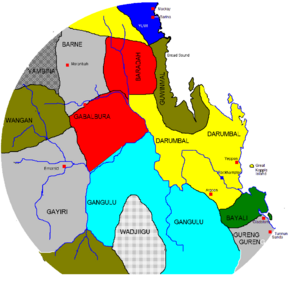Baradha people facts for kids
The Baradha people, also known as Barada or Toolginburra, are an Aboriginal Australian group. They traditionally lived in Central Queensland, not far from Australia's eastern coast. Their history and culture are an important part of Australia's rich Indigenous heritage.
Contents
Baradha Country and Lands
The Baradha people's traditional lands covered a large area, about 6,500 square kilometres (2,500 sq mi). This land included the area around the Connors River, stretching from Killarney north to Nebo. Their territory reached west towards Bombandy.
The Baradha lands were located between other Aboriginal groups. To their east, near the coast, were the Koinjmal people. To their west lived the Barna. The Wiri people were their neighbours to the north. Understanding these boundaries helps us learn about the different groups that lived in Australia long ago.
Baradha Social Structure
Like other Aboriginal groups in the Mackay area, the Baradha people had a special way of organising their society. They had two main social divisions, called phratries. These were known as Yungaroo and Wootaroo.
These terms were not just for people. They were also used to classify everything in nature, like animals and plants. Everything belonged to either the Yungaroo or Wootaroo group.
- The Yungaroo division had further smaller groups:
- Gurgela (for males) and Gurgelan (for females)
- Bunbai and Bunnbaian
- The Wootaroo division also had smaller groups:
- Koobaroo (for males) and Koobarooan (for females)
- Woongo and Woongoan
The Baradha people also had at least two known family groups, or kin groups:
- The Thararburra (also called Thar-ar-ra-burra) group lived mainly around Cardowan.
- The Toolginburra group's name comes from their word for "hill," which is tulkun.
Baradha Language
The Baradha people spoke a language called the Baradha dialect. This language was part of the larger Biri language family. Sadly, the Baradha language is now considered extinct. This means that there have been no known speakers of the language since before 1975. Learning about these languages helps us understand the rich cultural diversity of Aboriginal Australia.
History of Contact with Europeans
In 1770, Lieutenant James Cook sailed along the east coast of Queensland. He saw a group of mountains and named them the Glass House Mountains. This area was already an important meeting place for Aboriginal people. They used it for ceremonies, trading, and gatherings. Cook first landed in Queensland at a place now called Seventeen Seventy on May 24, 1770.
European settlement in the Mackay area began around 1860. During this time, the Aboriginal population faced many challenges. According to historical accounts, many people died due to conflicts with the Native Mounted Police. Others suffered from new diseases brought by Europeans, like measles, which spread in 1876.
The Baradha people, including the Toolginburra group, were among those who experienced these difficult times. By 1880, it is thought that only about 100 Baradha people remained. This period is a sad part of Australia's history, known as the Australian frontier wars.
Caring for Natural Resources
Today, a special group called the Traditional Owner Reference Group helps look after the land and important cultural sites. This group includes representatives from several Aboriginal nations whose lands are in the Reef Catchments Mackay Whitsunday Isaac region. These nations include:
- The Yuwibara people
- The Koinmerburra people
- The Barada Barna people
- The Wiri people
- The Ngaro people
- The Gia people
- The Juru people
This group works together to support natural resource management. They also protect cultural heritage sites that are very important to Aboriginal people. This work helps keep the land and its history safe for future generations.
Images for kids



